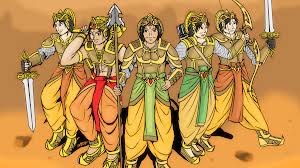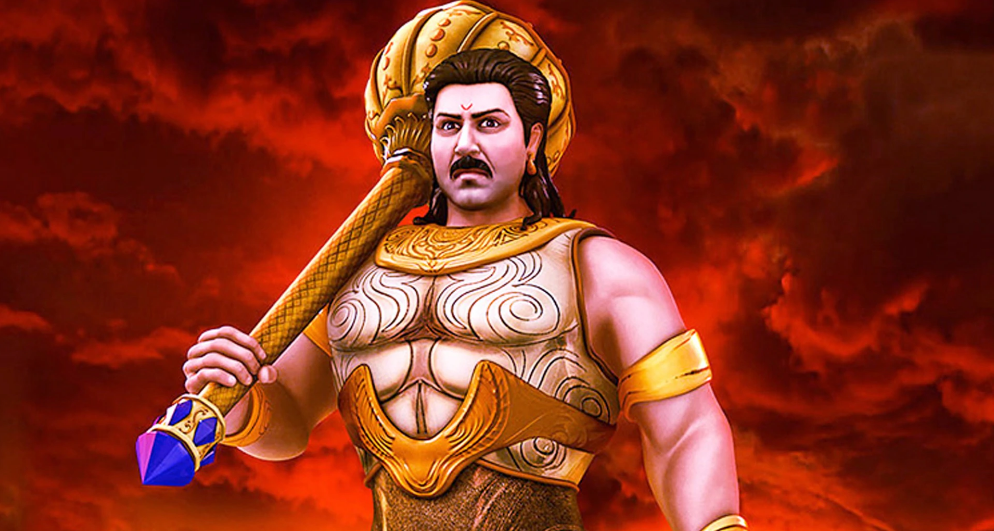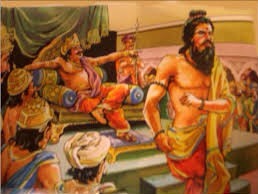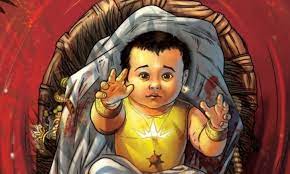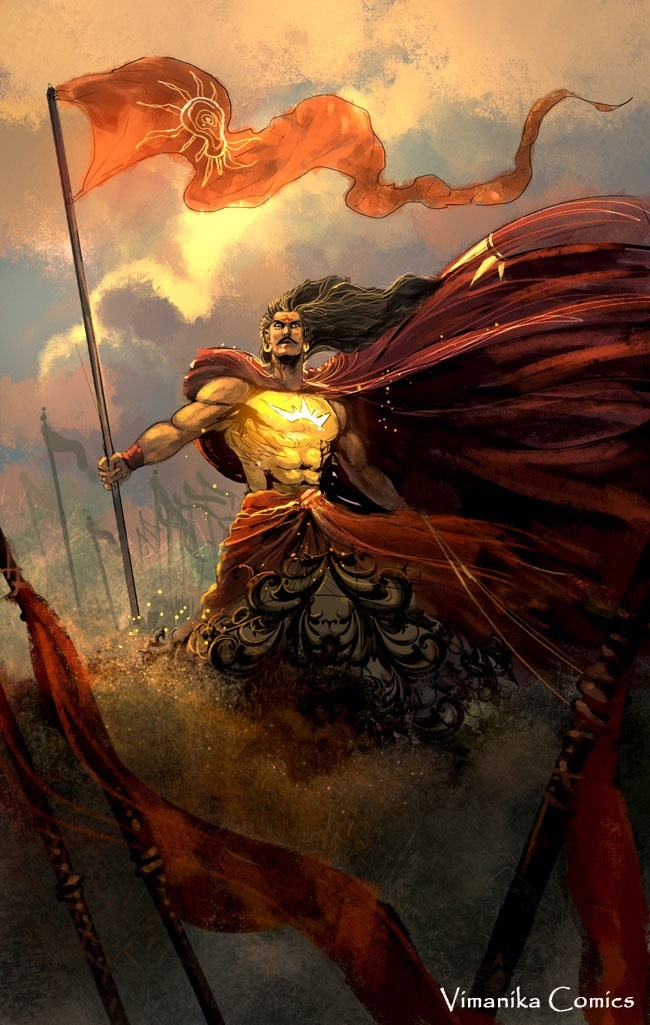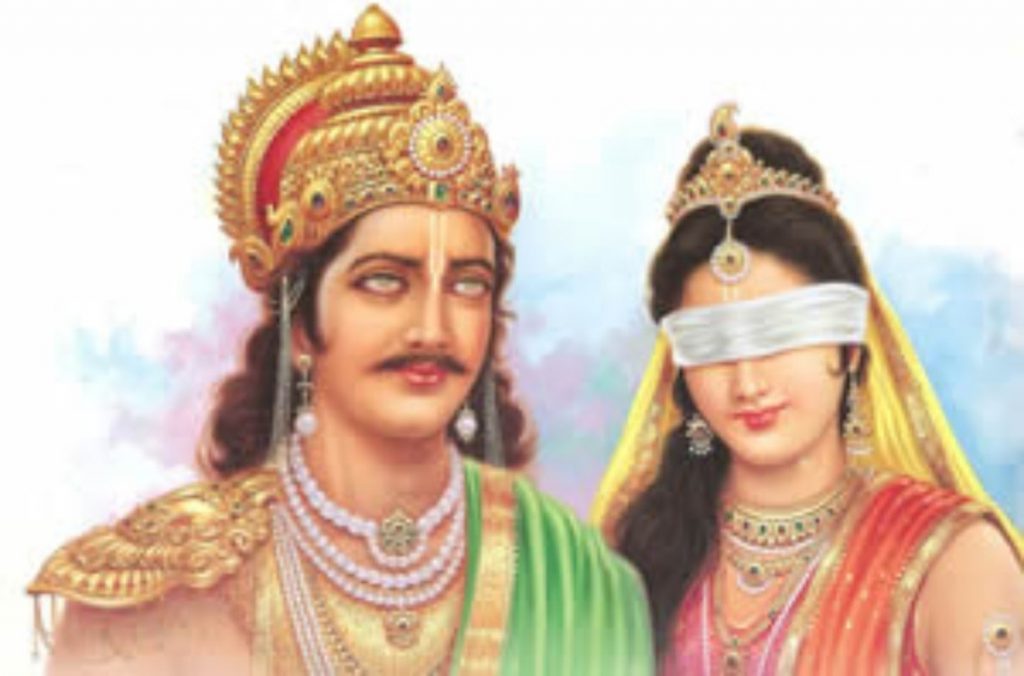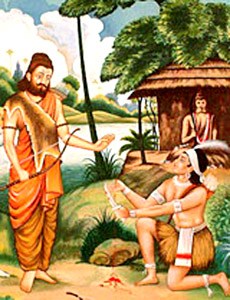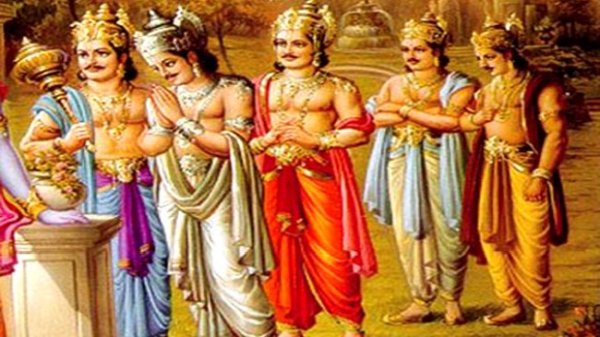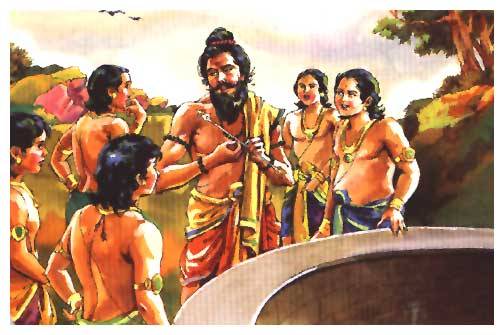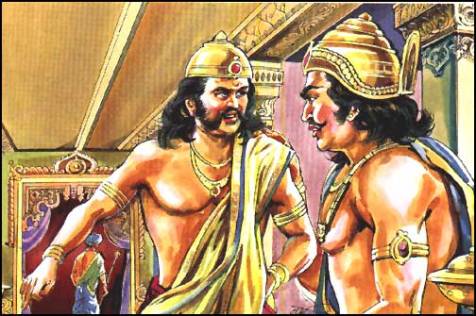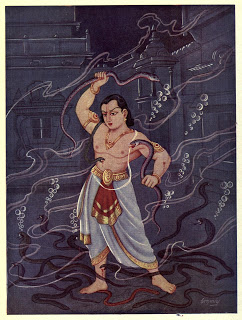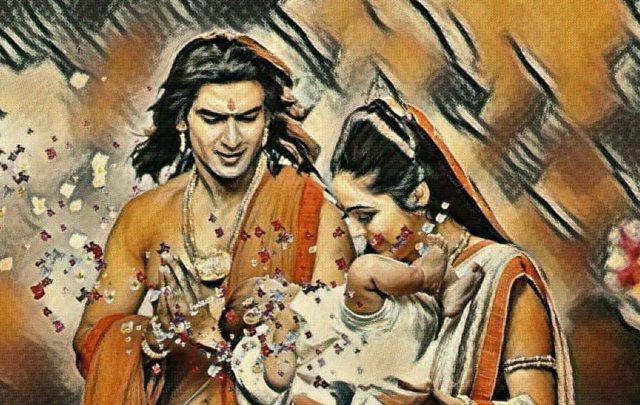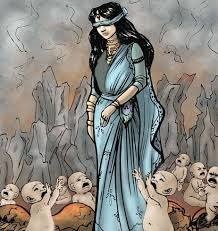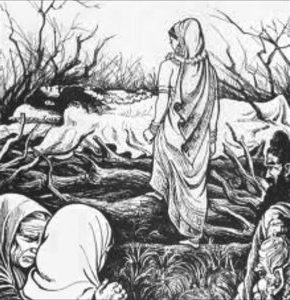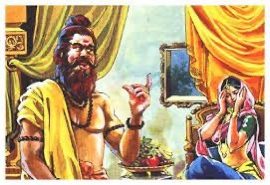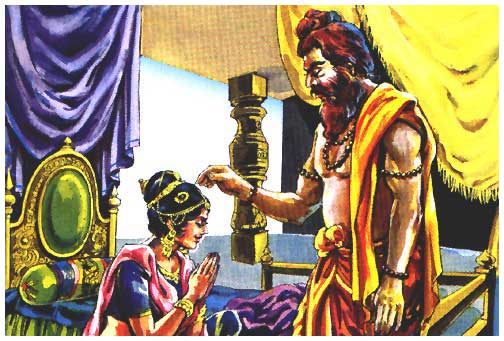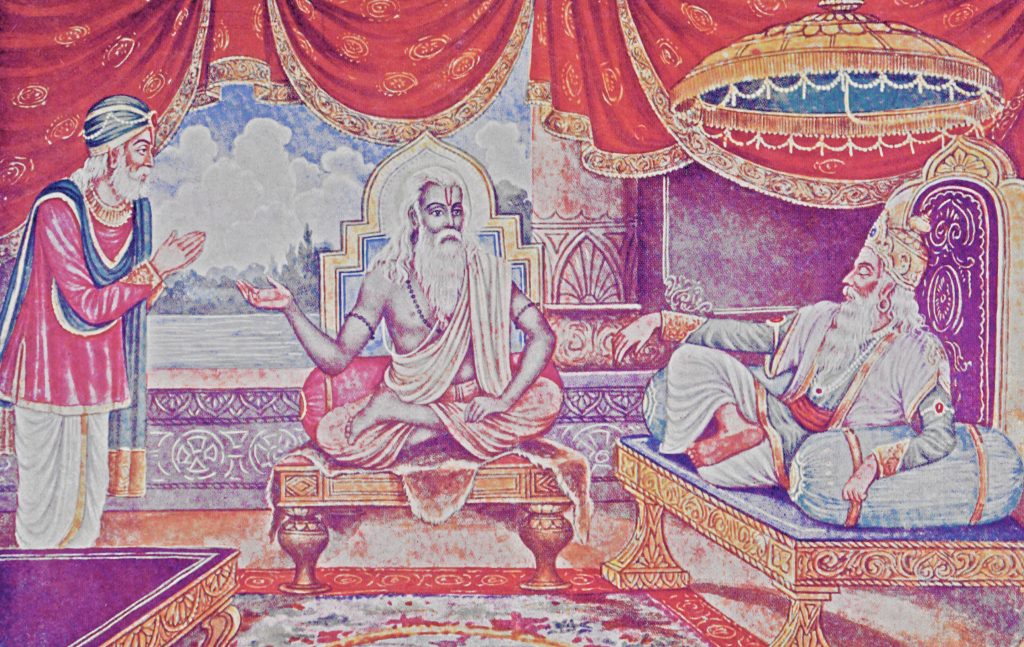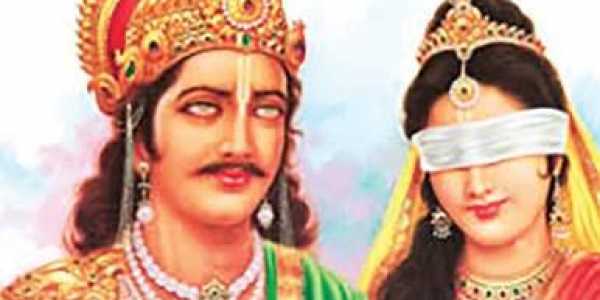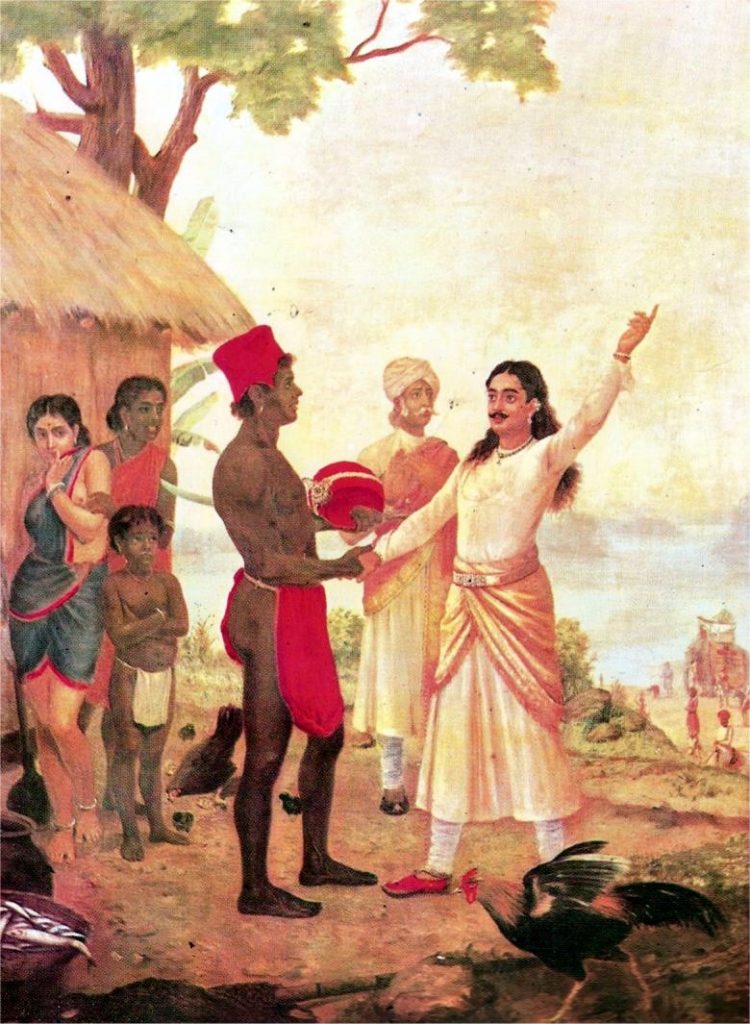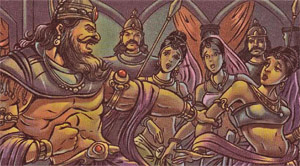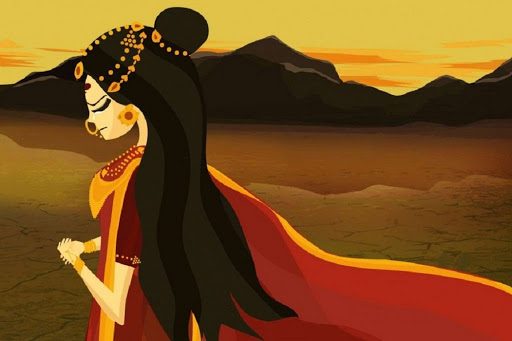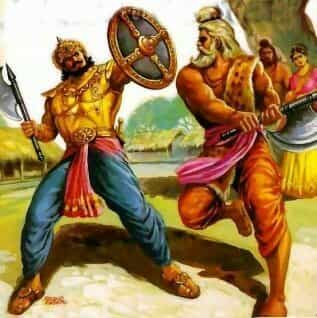By Nirooshitha Sethuram
The Pandavas with their mother Kunti continued their journey through the forest, facing many hardships along the way. As they couldn’t find any safe and suitable place to stay, they wandered around. One day they came across Sage Vyasa. Even though they did not know who he was, yet the Pandava brothers paid their respects humbly. The great sage blessed them all. Staring at his face, Kunti recognized him. She had seen him when he came to the Royal Palace in Hastinapura to escort Queen Satyavati with him to his ashram when she renounced the royal life. Recognizing the sage as none other than Vyasa, Kunti burst into tears and narrated all that happened to them.
The sage counseled her to keep patient. He gave her the teachings of the reality of life, advising them to follow the path of righteousness and be patient in adversity. He promised that prosperity is bound to follow for those who walk on the path of righteousness.
Sage Vyasa directed them towards a nearby town named Ekachakra. Following the advice of Sage Vyasa Kunti and her sons went to Ekachakra and started living in disguise as bhramins in the house of a brahmin.

They went begging for alms in the town by day, coming back at dusk with the alms. Whatever they brought, they placed before their mother Kunti. She divided all of it into two halves. One half was given to Bhima alone while the other half was shared by her and his four brothers. The major share was given to Bhima as his immense appetite had to be fulfilled at any cost. Bhima was also called “Vrahothan” due to his huge appetite. Vrahothan means a person with a wolf’s stomach. A wolf’s stomach is small, making it hard for its appetite to be satisfied. Bhima was the gift of Vayu Bhagavan, the God of wind, thus having his characteristics, fiercely forceful, strong and the biggest appetite ever.
Kunti would weep every day seeing the sad state of her sons. The Royal Princes of Hastinapura were begging for food as mendicants. But the Pandavas would console her by all means, telling jokes and acting silly to make their mother laugh. Soon the Pandavas became popular among the people of the town because of their virtuous deeds.
One day, as Kunti was ill, the four Pandavas went on their daily begging, leaving Bhima to take care of their mother. While resting, all of a sudden Kunti heard a huge cry coming out of the brahmin’s house. She immediately alerted Bhima and went to their home. The whole family was in tears, sobbing while sitting in a very frightened state.
The brahmin father was saying to his wife, “Oh, I was anticipating this day from the beginning and advising to leave this place. But you did not heed my advice. See, the imminent danger is knocking at our door right now. You are a pious and a patient lady, following my dharmic path. Like a mother you are nourishing and nurturing me. The very gods have sent you as my friend, philosopher and guide. How can I now desert you and go there?”
He continued, “See our cute small son. He has not yet grown; he is still a child. How can I leave him? This is our beloved daughter. The gods have given her to me for me to perform Kanyaadaana (gift of a maiden in marriage). I and my forefathers will attain divine abodes by virtue of the children born to her. A few may say that the father loves his son more, and a few others say that he loves his daughter more. I love both of them equally. Now what can I do? I can’t leave them,” the brahmin grieved.
The Brahmin’s wife said, “Oh, my lord! Don’t lament over this issue. Today I will go and sacrifice my life. A wife is supposed to protect her husband. That is dharma. You married for progeny, and I got relieved from the debt by giving children to you. The purpose of my life is fulfilled. If you die and I outlive your death, I can’t bring up these two children on my own. I can’t even protect this girl from the evil eyes of envious men. Further, a lady without a husband would be akin to the fallen flesh ready to be picked up by all men around. I can’t protect myself and lead on the dharmic path. I will be despised and demeaned.” She continued, “Further, a woman is not to be killed as per dharma. Thus the demon may leave me because I am a woman. A man is certain to be killed but a woman has the chances of being relieved. Hence, only I should go and do my duty as a wife.”
Hearing this from her mother, the brahmin’s daughter offered to sacrifice her life. “Listen to me. I am your daughter and one day you must let me go with whoever I marry. I will save my parents by sacrificing my life and leave you now. Oh father, for the sake of dharma, and for the sake of all of us let me die for a noble cause.”
Then the small boy came up with a stick and childishly said that he would kill the demon with the stick, and that he would go to the demon the next day. Everyone hugged him for his innocence. Then the father said, “Death for all of us is the only alternative.”

https://www.boldsky.com
At that point Kunti entered the house. They all looked at Kunti as she asked them for the reason for their sorrowful state. When they hesitated, Kunti insisted the brahmin to explain what is going on in the town that she is not aware of. She said to consider she and her sons as family to the brahmins.
Hearing this brahmin said, “A man-eating demon named Bakasura lives on a hill near this town. To protect the town from the terrible demon and to live without fear in the town, the elders of the town have made a deal with him. According to the deal, the town will send a human being along with a bullock cart full of food daily to satisfy the hunger of the demon. For this to happen, every family has to send one of its members when their turn comes. By doing this the town is protected from Bakasura’s raid. As you can see, it’s my turn to arrange for the demon’s food tomorrow. Each member of my family was insisting on going but finally we have decided that all of us should go, to be devoured by the demon.”
Kunti was listening quietly. Then she consoled them by saying one of her sons will go instead of them. The brahmin family were delighted to hear the consoling words of Kunti. The father thanked her for her kindness & compassion towards them. Then he said, “The misfortune that we are going to face cannot be shared by anyone else, as every family in this town has to face this when it’s their turn.” He continued and said that they are guests. In order to save his family, he would not let guests sacrifice one of their family members. The wife joined in with her husband on the matter.
Kunti assured them that her son Bhima would be the best person to deal with the demon. “He will not only save your family, but also all the other families in Ekachakra.” She added that she and her sons are obliged to the brahmin family in many ways, and it’s their duty to be there for them. Hearing of Bhima’s valor from Kunti, they decided to agree to her proposal.
Kunti went straight to Bhima and told him about Bakasura. She instructed him to put an end to the demon. She emphasized that it’s their duty to stand by the brahmins in this time of adversity. She was so grateful to the brahmin family who had embraced them when they walked into the town by giving them shelter. Bhima was delighted to have this opportunity to fight for the brahmins and the town. He bowed his head to his mother and asked for her blessings to kill the demon.

When the other four brothers returned home Kunti narrated the incident to them as well. Hearing this, Yudhishthira didn’t like the idea of Bhima putting himself into danger, knowing he was the one who can protect their family. However, Yudhishthira also realized it is kshatriya dharma, the righteousness of a royal prince and warrior. He blessed Bhima to go fight the demon.
The next morning, Bhima set out towards the demon’s dwelling with a cart loaded with food. Once he reached the destination, he unloosed the bullocks pulling the cart and started eating the food which was meant for the demon. While eating all he had brought, he made loud noises to get the attention of the demon.
When Bakasura heard a human voice, he came out of his dwelling and was shocked to see his victim eating his food and making loud noises. Bakasura was an awfully ferocious demon with a wide mouth, big teeth and fiery eyes. He was already hungry and waiting for his daily food and he was enraged at what he saw.

https://moralstories.wordpress.com
Bakasura thundered, “You human! How dare you touch my food and ignore me. Are you wishing to die the worst cruel death in my hands? I will happily grant you your wish!” He advanced towards Bhima. Bhima simply ignored him and went on eating. The ferocious demon was unable to hold his anger and attacked Bhima.
Bakasura was taken by Bhima’s might. Without losing any time, Bhima sprang at his opponent in full force. He lifted the demon up and hurled him violently to the ground. The demon could not stand the attack and fell down on the ground with a heavy thud, dying on the spot. Bhima put a cloth around the neck of the dead demon and dragged his body to the town. Leaving it there to be viewed by the townspeople, he quietly went home.
Soon the people of the town came to know of the fearful demon’s death and assembled to see his dead body lying at the outer gate of the town. The news spread like wildfire in the entire neighboring area and people began to dance in joy, reveling in their newly found freedom.
Everyone in the town was astonished by the mysterious death of the demon. They tried to figure out who would have killed the demon and dragged his body to the town. It remained a puzzle for them. The brahmin family knew everything, yet they kept their mouth shut.
More to come…
Images:
- Vyasa https://1.bp.blogspot.com/-Gqb0AQXE3pg/YEYp5S8AnHI/AAAAAAAAchY/Glga8WyRLJcrpslqz-MXWwfNrbk59e7kwCLcBGAsYHQ/s728/How%2BSage%2BVyasa%2BGot%2BThe%2BName%2BKrishna%2BDwaipayana%2BVyasa.jpg
- Bhima https://en.wikipedia.org/wiki/Bhima#/media/File:Vintage_Bhim_oleograph_litho_Ravi_Varma_Press_B.jpg
- Kunti and the Brahmin family https://www.boldsky.com/yoga-spirituality/anecdotes/2015/mahabharata-stories-why-did-bhima-fight-bakasura-066730.html?story=4
- Bhima eating Bakasura’s food https://www.templepurohit.com/bakasura-the-rakshas-of-ekachakranagara/ by Sumo (http://sumo.com/)
- Bhima & Bakasura https://moralstories.wordpress.com/2006/08/25/ekachakrapura-baka-vadha/






